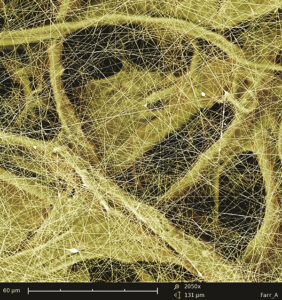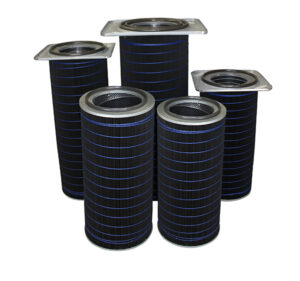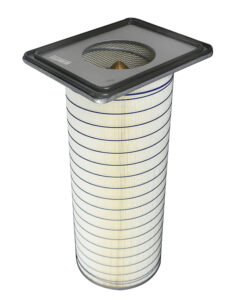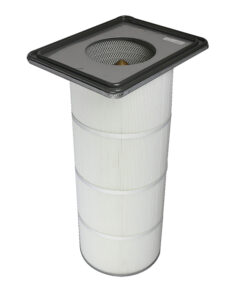Selecting the Right Dust Collector Filter Media for a Safer Work Environment
By Randi Huckaby, Contributor
High-efficiency, cartridge-style dust collectors are critical for protecting workers and equipment from harmful dust and fumes. However, a dust collector is only as efficient as its filter cartridges. When working at peak performance, filter cartridges should capture the maximum amount of dust and air pollutants, and then thoroughly release them into a collection hopper when pulse-cleaned.
In addition, filter cartridges must be equipped with media that is appropriate for the specific application and dust. Selecting the correct media creates a safer, cleaner work environment with less dust-collector maintenance. Using the wrong media can lead to increased energy usage or worse: It can put workers at risk from dust exposure and possibly create conditions that can lead to an explosion.
Filter Media and Cartridge Construction
 Look for a filter whose construction and media type allows it to be firm to the touch. The media alone may not be stiff enough, but when combined with the proper pleat depth and spacing, it becomes strong.
Look for a filter whose construction and media type allows it to be firm to the touch. The media alone may not be stiff enough, but when combined with the proper pleat depth and spacing, it becomes strong.
Paired with the proper construction and support, the filter cartridge should be able to withstand clamping force and even compression. Pleated media is used to collect and release dust from the filter. Being able to maintain this structure during air flow and pulse pressure is important, as it keeps pressure drop lower and air flowing through the filter for a longer time. The open, breathable design also cuts down on compressed air usage and reduces the energy demand on the motor.
Some wide-pleat filters use synthetic bead pleat separators to ensure pleats are kept wide and open for the best dust release possible. These separators prevent the media from folding over on itself, which causes the filter to plug.
Note that a wide-pleat filter will often contain less total media area than a tightly pleated model. However, the total square footage of the media is not significant. What is important is the total square footage of usable media and the efficiency of the media to ensure the proper particle sizes are captured.
Filter Media Treatments
 Two basic types of media are commonly used in pleated cartridge filters. Which to select depends on dust type, operating temperatures and the level of moisture in the process. Media made from non-woven, cellulosic blend is appropriate for dry dust-collection applications at operating temperatures up to 160 °F (71 °C).
Two basic types of media are commonly used in pleated cartridge filters. Which to select depends on dust type, operating temperatures and the level of moisture in the process. Media made from non-woven, cellulosic blend is appropriate for dry dust-collection applications at operating temperatures up to 160 °F (71 °C).
Synthetic polyester media and polyester-silicon blended media are lightweight and washable. They can handle dry applications with maximum operating temperatures ranging from 180 °F (82 °C) up to 265 °F (129 °C). Although polyester filter media is washable and can recover from a moisture excursion, it is not intended for wet applications.
There are several treatments for both cellulose and synthetic filter medias that can enhance their efficiency and dust-collection performance. Here are a few of the most common treatments:
Nanofibers: When a layer of nanofibers is applied on top of the base media, whether cellulosic or polyester, the nano coating promotes surface loading of fine dust and prevents the dust from penetrating deeply into the filter’s base media. This translates into better dust release during cleaning cycles and lower pressure drop readings through the life of the filter—which, in turn, promotes longer filter life, as well as energy savings.
Flame-retardant treatment: Standard and nano filter media can also be treated with a flame-retardant chemical for use where there is a risk of fire or explosion.
Anti-static media: Conductive or anti-static filters may be used where conveyed dusts generate static charges that require dissipation. Typically, static dissipation is achieved by impregnating a cellulose filter with a carbon coating or a synthetic filter with an aluminized coating or carbon grid impregnation.
PTFE treatment: Filter media can be laminated with polytetrafluoroethylene (PTFE) membrane for very high efficiencies of fine particulate and superior dust cake release.
Hydro-oleophobic treatment: Filter media can be coated with an oil- and water-repellent finish to be used when there are some vapors in the process.
To help decide which cartridge filter media is right for a specific application, it is important to consult with experts and have dust testing performed. Here are common dust types and filter media considerations.
Harmful and toxic dust: Many facilities produce airborne dusts and fumes that are hazardous to inhale. For example, welding certain metals sends hexchrome fumes that can cause lung disease. Pharmaceutical manufacturing can produce potent airborne compounds, and chemical processers can produce silica dust. Because of this, the EPA and OSHA might require higher efficiency filters, which can be achieved by using media that is chemically treated with a layer of nanofibers or PTFE.
Hygroscopic and sticky dust: This type of dust absorbs moisture as it moves through the airstream. Once in the dust-collector filter cartridges, this dust can become sticky like mud and cause the filters to plug. Hygroscopic dust is common in the food processing industry, where ingredients contain fats and oils. It helps to use filter cartridges with wide pleats and to select filter media that is treated with oil- and water-repelling compounds, like PTFE, that coat the fibers and promote dust release. The right selection can provide extremely effective filtration, even for very sticky dusts like sugar.
 Fibrous dust: This type of dust is common in applications that process wood, paper, sand and cellulosic food ingredients. These particles resist release from the filter cartridge, because the fibers attach themselves to cellulosic media fibers at the surface and cut edges. The solution is to use a spunbonded heavy-duty filter media that has a smooth surface. For extremely difficult cases, media can be used that is coated with air-permeable, anti-stick surface coatings like PTFE. More dust is released with each pulse, keeping the filters operating efficiently longer.
Fibrous dust: This type of dust is common in applications that process wood, paper, sand and cellulosic food ingredients. These particles resist release from the filter cartridge, because the fibers attach themselves to cellulosic media fibers at the surface and cut edges. The solution is to use a spunbonded heavy-duty filter media that has a smooth surface. For extremely difficult cases, media can be used that is coated with air-permeable, anti-stick surface coatings like PTFE. More dust is released with each pulse, keeping the filters operating efficiently longer.
Flammable dust: In metalworking applications, such as plasma and laser cutting, grinding or welding, there is a higher risk of fire or explosion. Dust testing for burnability and flammability determines if flame-retardant media is required. If it is positive, select filter media that is saturated in a resin containing fire-retardant chemicals. Dust testing also determines the dust’s minimum ignition energy, which determines the need for media coated with a conductive or aluminized finish.
Statically charged dust: Some types of dust build up static electricity when they are collected and moved into the dust collector. These dusts include dry food products, fumed silica, PVC and toner. The dust particles can attach to filters with a strong electrical bond, which prevents the dust from being released with pulse cleaning. This dust can ignite a dust explosion if it isn’t dissipated. Cartridge filters with antistatic media can also be used in explosive dust applications, making it possible to conform to NFPA requirements and lessen the risk of ignition sources due to static electricity charges.
 Allergens and irritants: Food manufacturers must prevent cross contamination, especially when producing foods that are gluten- and allergen-free. Also, the EPA may require high-efficiency filtration, which can be achieved with nanofiber filter media. Coating the media with a layer of nanofibers gives the base material larger pore sizes, which provides superior dust release and efficiency without increasing pressure drop.
Allergens and irritants: Food manufacturers must prevent cross contamination, especially when producing foods that are gluten- and allergen-free. Also, the EPA may require high-efficiency filtration, which can be achieved with nanofiber filter media. Coating the media with a layer of nanofibers gives the base material larger pore sizes, which provides superior dust release and efficiency without increasing pressure drop.
Nuisance dust: These airborne particles in the workplace are not harmful to the human body, if the levels of concentration in the air and the duration of exposure are kept below OSHA’s permissible exposure limits (PELs). This dust is produced from manufacturing activities such as grinding, sanding and polishing. For these applications, standard filter media made from a nonwoven or cellulosic blend treated with a material to provide moisture resistance is appropriate.
The Right Filters and Media for the Job
Effectively controlling dust and fumes is essential for the safety of employees, quality of products and regulatory compliance. A high-efficiency dust collector designed specifically for an application is an accepted and proven engineering control that will filter hazardous contaminants and combustible dusts to make indoor environments safer. Choosing the right filters and media will improve the overall efficiency of the system and lower energy and operating expenses but, most importantly, will make sure the work environment is safe.
About the Author
Randi Huckaby is Product Manager—Dry Filtration APC Global, at Camfil Air Pollution Control. Camfil APC is a global manufacturer of dust, fume and mist collection equipment and part of Camfil, the largest air filter manufacturer in the world. For more information, call 1-800-479-6801 or 1-870-933-8048; email filterman@camfil.com; or visit www.camfilapc.com.







